Last time, I wrote about being sent to a place I had never heard of, Zadar, by a generous benefactor (aka my brother). If you too would like the chance to confound me with some industrial wasteland of an Albanian city or a remote Norwegian archipelago –and you’d like to support this publication in a massive way—click here.
I learned of the Sea Organ from the hotel receptionist in Zadar. He had seemed momentarily stumped when I asked what the city was known for (although in hindsight I suspect that his pained silence was more likely stupefaction at the idiocy of my question than difficulty coming up with an answer.) But after gently reminding me that Zadar was 4000 years old, he came up with a relatively modern attraction: the Sea Organ. It was, he said, a piece of art that made music and was in the sea, and I had to see it.
The name worried me—I couldn’t help but picture some kind of giant marine phallus swaying menacingly from the ocean floor. But the receptionist’s description was only slightly less confounding. I imagined a pipe organ, the kind you find in churches, only underwater. What I couldn’t quite figure out was how you would see it, let alone hear it. Also: who played it? Were a bunch of guys in wet suits and oxygen tanks down there banging out Toccata in D Minor?
None of the above. I went to see the Sea Organ at sunset, along with about half the population of northern Europe. Hundreds of people were seated along a set of smooth, low steps that bordered the sea, their faces turned to the west, their phones held aloft. With a crowd that size, there was a lot of chatter, so it took me a minute to notice the sound emanating seemingly from beneath them. It was low, rhythmic, and haunting, somewhere between a Philip Glass composition and the sound the dragons make in Game of Thrones when they’re still out of sight and haven’t started shrieking yet. Gradually, the sound resolved into something like a melody.
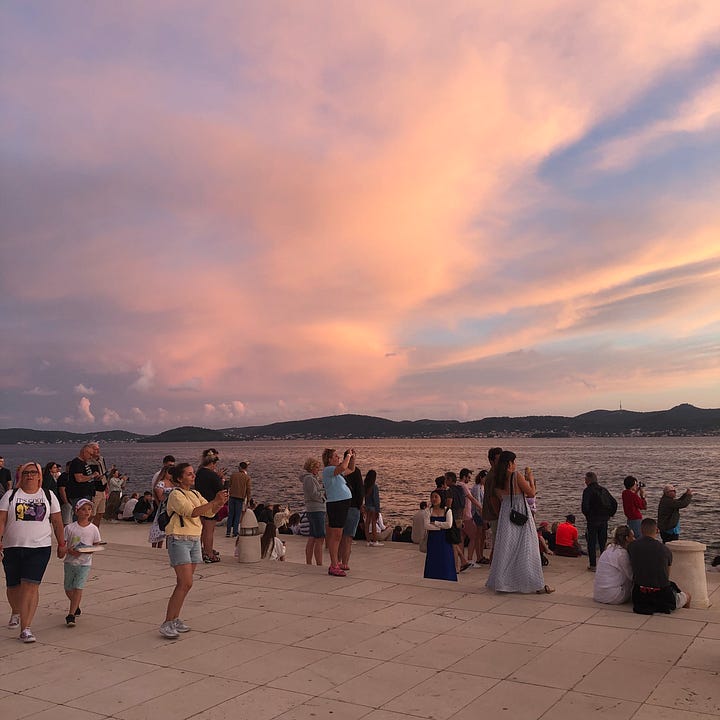
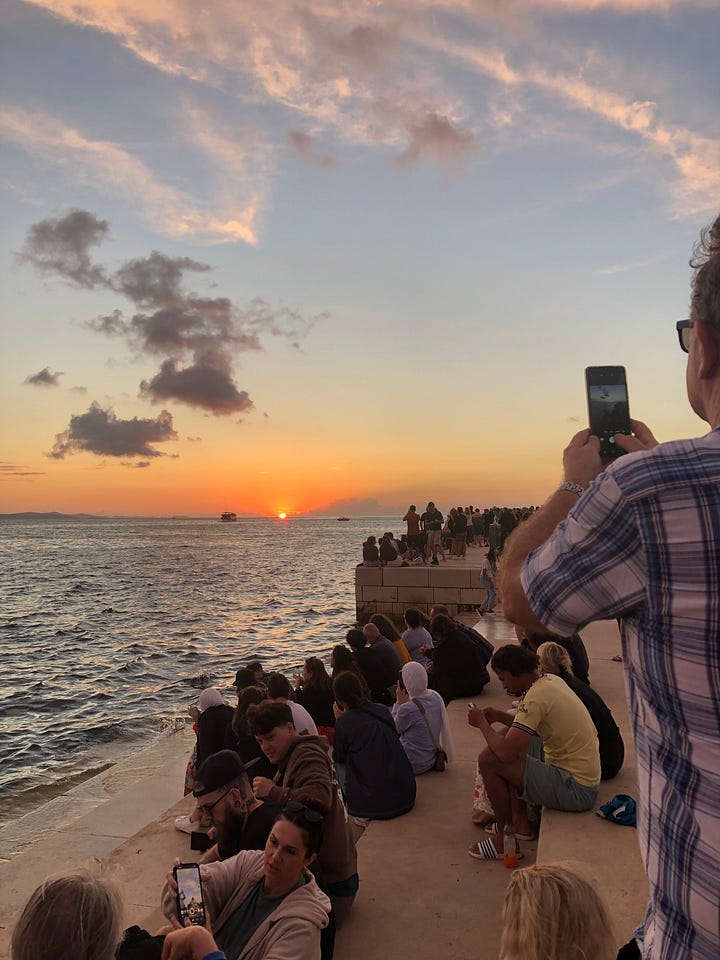
The Sea Organ, I learned, was both architecture and instrument. Inaugurated in 2005 as part of the reconstruction of Zadar’s waterfront after the Yugoslavian wars of the 1990s, it was designed by the Croatian architect Nikola Basic and consists of a series of underwater pipes and chambers. When water is pushed through them by the wind, waves, and tides, the air in them vibrates, making what some describe as experimental music. (Or, as one especially effusive tourism website puts it, “It is an instrument played by the wind, waves and moon.”)
Combine the Sea Organ’s hypnotic sounds with some frankly spectacular sunsets, and you’ve got Zadar’s most popular tourist attraction. But I noticed that as the sun dipped below the horizon, most of the crowd didn’t leave–they just shifted a few meters further down the promenade, and took an expectant stance along the circumference of a large glass circle set in the stone pavement. Finally, as it grew dark, spots of colored light began to glow dimly from the circle.
This was another Basic installation, called Greeting (or Monument, translations differ) to the Sun. Comprised of layers of photovoltaic plates that absorb sunlight during the day, the circle releases that energy at night, like a giant, muted LiteBrite set. And once that happens, people pour onto the glass and begin posing.
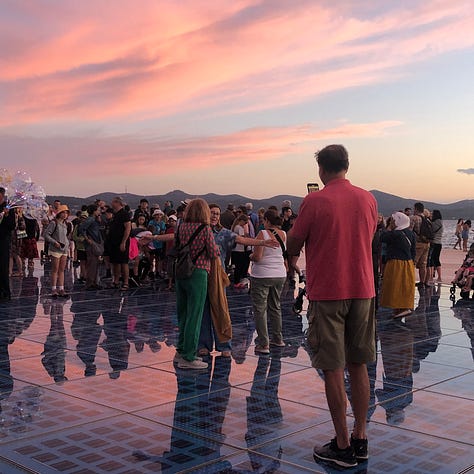

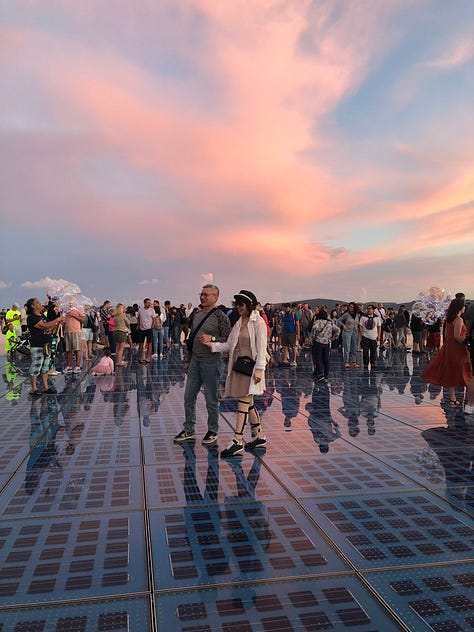
Basic finished this piece in 2008, so he couldn’t have imagined the effect that Instagram would have on his work, but of course the Greeting to the Sun today is a veritable orgy of selfie-taking. On that night, there were a few children, freed from their photographic responsibilities, who ran squealing across the circle. Quite possibly the saddest-looking man I have ever seen—shell-shocked eyes, slight tremor in his hands—paced the glass with a bouquet of transparent balloons that no one seemed to want. But almost everyone else was taking pictures of themselves, of their companions, of the disappearing sun and the glowing lights doing their thing.
When I got back to Copenhagen, a friend who had been to Zadar with her partner a few years earlier laughed at how underwhelming it all was. “We kept asking each other, ‘is this it?’” she said. I understood her point. Maybe the city elders were hoping for a Bilbao effect—that the Sea Organ and Greeting to the Sun would actually draw tourists to the town—but it was hard to imagine that the two pieces delivered in that sense. But now that they were there, they had each become the thing you had to do, the thing that proved you were in Zadar.
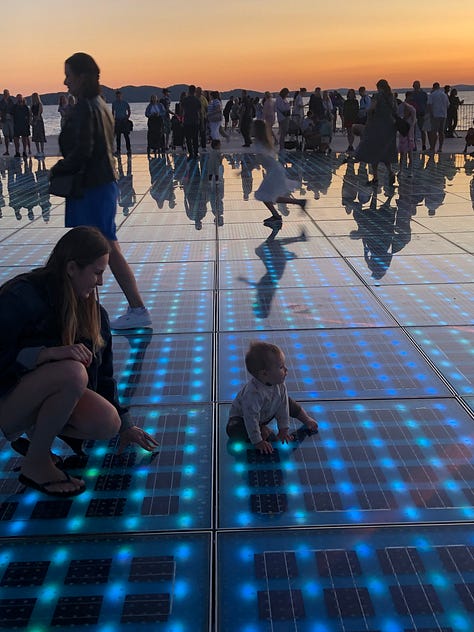
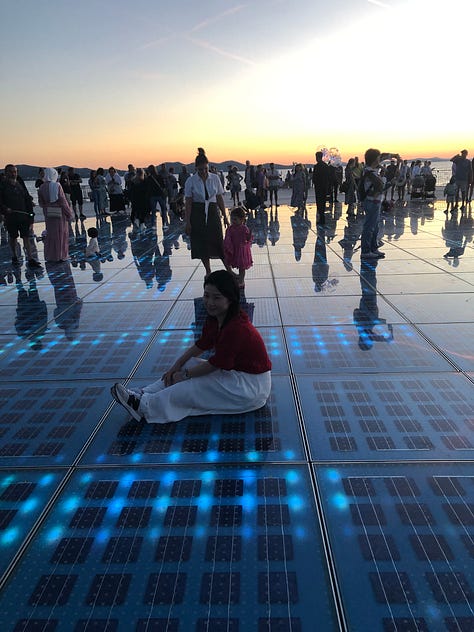
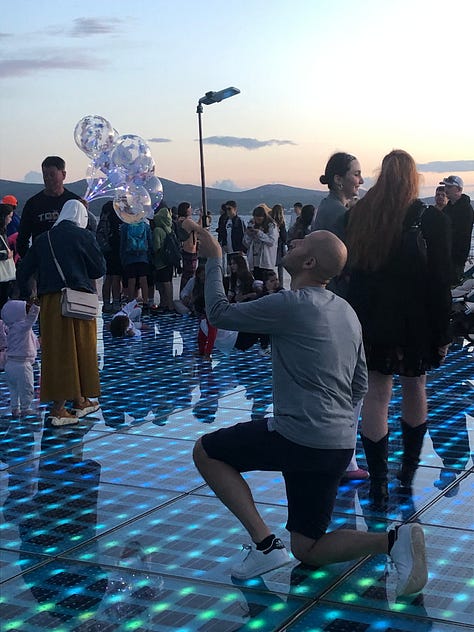
I went back each night I was in Zadar, and it was the same every time. The crowds were again taking photos of the technicolor sky, and as the sun disappeared, they moved over to the Greeting, and began taking photos of themselves there. The tragic balloon vendor was there too, with his never-diminishing bouquet of transparent balloons. On my last night, I tried to strike up a conversation with him, but language got in our way, and I never got further than a nod in response to my question of whether he was there every night. Still, he smiled at me, long enough for me to wonder if I had misread his sadness.
As I walked away, more eerie music emanated from around the Sea Organ, gradually growing louder and more melodic, until I realized it wasn’t the Organ at all. A group of women had formed a small circle, and were singing a hauntingly beautiful song in Croatian. Everyone along the promenade fell silent as they listened.
I ran up to speak with one of the singers as they started to walk away. Ida told me that they were a female firefighter chorus, called Alegrija; and were in town to perform at one of their fellow firefighter’s work anniversary. They hadn’t planned to sing at The Sea Organ, but as they were walking back to their hotel, something moved them. “It just seemed magical,” Ida said.
She was right; it did. Something about the music those firefighters made, and the way their voices merged with the Sea Organ’s bass notes, and the way that everyone stopped for a few minutes and just listened, was indeed magical. As the lights from Greeting to the Sun glowed bluish-green, people again took up their poses. But it was easier now to see them less as tourists trying to consume one more thing, and more as just people looking, even when they don’t expect it, for the sublime moment.
On my last day in Zadar, I got up early and went back to the Sea Organ. This time, I had its expanse of smooth white steps entirely to myself. I sat down with a cup of coffee, and looked over the lapping sea at the island across the way. I sat there a long time, long enought for something in me to feel profoundly soothed by the tones coming from below. Without the chatter of the crowds to dull the Sea Organ’s sounds, I began to detect the patterns in its music. I could hear crescendos when a passing fishing boat left a wake, and adagios when the wind died down.
I knew that soon, the crowds would be back, and the Sea Organ would, for many of them, be little more than a curious soundtrack for their sunset selfies. But in that moment, it felt like so much more: like the sea was speaking, like someone had given it a voice. All I wanted was to stay, and hear what it had to say.
What I’m Reading
I’m going to take some liberties with that heading, basically to self-promote.
I talked about this very newsletter for a podcast with Nicholas Gill, whose captivating New Worlder—which focuses mainly but not entirely on food in Latin America—is a favorite.
And, after a lightning reporting trip south earlier this month, I wrote about overtourism in Barcelona for the New York Times.
But enough about me! For another take on overtourism, this one based out of Florence and focusing on what all those lines are doing to the city’s food scene—to say nothing of its mortadella—check out Emiko Davies’ smart essay.
I recently came across Narina Exelby’s newsletter NE Where, and quickly realized we have a lot of common interests. After a flurry of text messages, she directed me to this wonderful piece she published four years ago, in which she got some fierce-looking old schoolers to talk about what travel was like back in the day.
And speaking of back in the day: one of the inspirations for this newsletter was a column that Matt Gross used to write for the New York Times, in which he deliberately tried to get lost. It was a wonderful series, but it was relatively short-lived because even then—it was 2010—he was already finding it difficult to actually get lost. But the columns live on; Matt recently collected them all and put them online. Read them here.



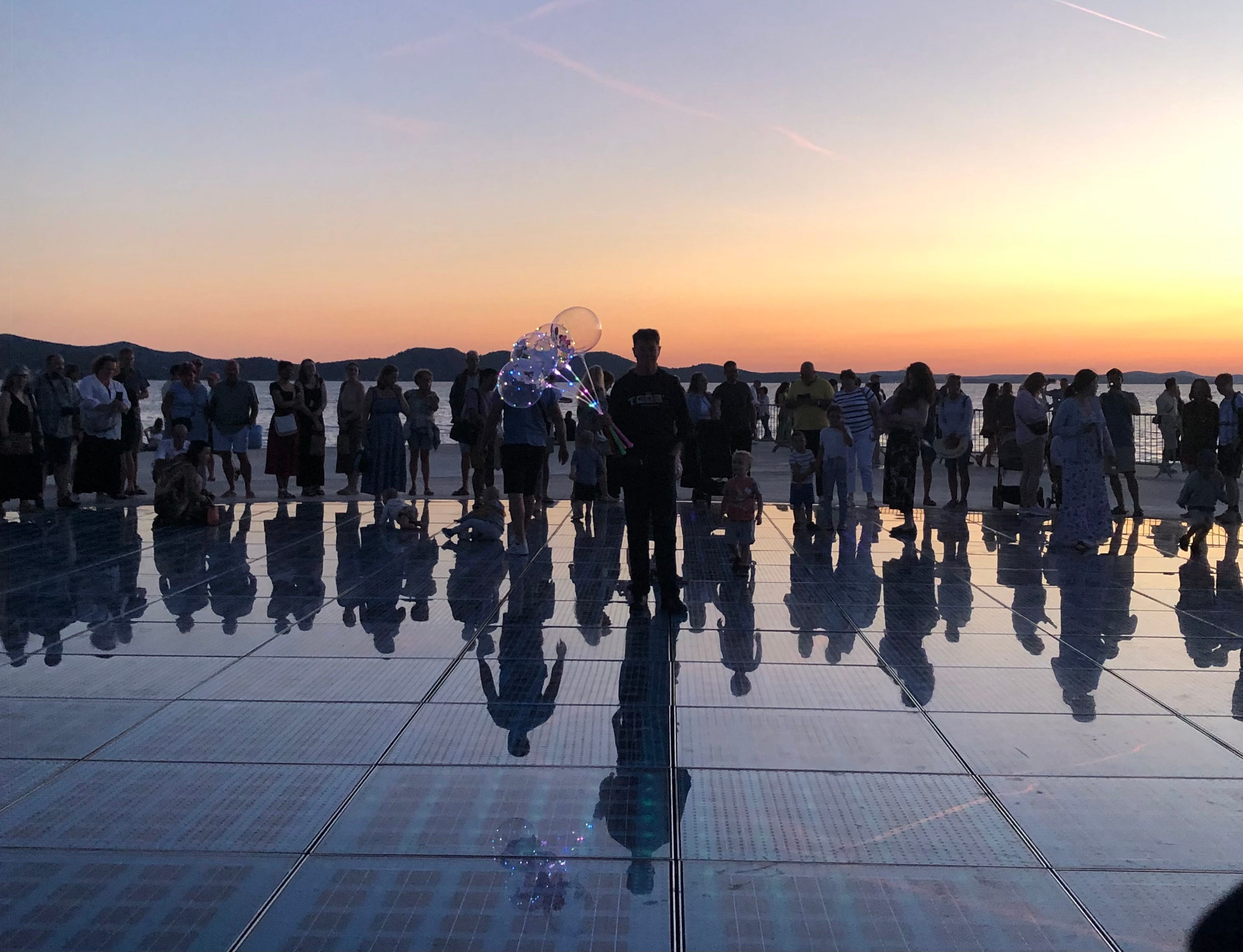

As always, your writing is beautiful and yes, transporting. And those women singing ... how wonderful - xoD
As inveterate early risers when we travel to enjoy the most overtouristed places as they should be, your ending reslly resonated, Lisa. Not that we want to encourage this!